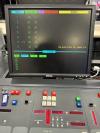Galaxy Nova
The Galaxy Nova, which David Bertenshaw helped create while at Strand and which he has now immaculately restored to full working order, the first in an ongoing project to restore one of each generation of Galaxy, en-route to Classic Gear Live at PLASA.
Having talked about the group masters pioneered on the National Theatre Lightboard and then incorporated into Galaxy, I am very much looking forward to three days of playing with them, introducing them to people, and wondering aloud why no current console has anything like them!
Post PLASA, this Galaxy will head to its new home at Rose Bruford College. Why not join us on the Classic Gear Live stand (D55) on Monday at mid-day for the ceremonial 'handing over of the power key'. Because consoles of a certain generation always had keys!
Galaxy built on the operational philosophies of previous Strand memory consoles, like DDM and the National Theatre's Lightboard, but using microprocessors instead of mini-computers.
The console used Motorola's 6809 processor, which could handle only 48 channels, not nearly enough for the biggest venues Galaxy was intended for. To increase capacity, you added extra processor cards to the system, up to maximum of 768 channels, and for the biggest shows additional RAM, in 32KB blocks to a maximum of 128KB on the original consoles.
Its modular and cusotmizable control surface offered memory and channel controls, fader modules, and a unique muti-wheel group master module. Unsure what to name their new product, Strand originally shipped it with reversible badges, DDM3 on one side, Galaxy on the other. Later generations, up to Nova shown here, improved its capabilities including adding support for DMX, up to its retirement in 1996 - though it remained popular in TV studios for years afterwards.








